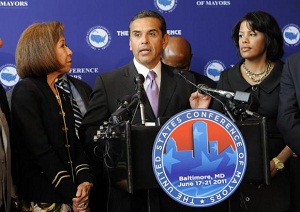Study: Mayors believe in solar
 Mayors from every city of more than 30,000 people gathered in Baltimore, Maryland, last week to discuss pressing issues facing American cities and their leaders. Chief among the issues discussed was clean energy, including the deployment of solar power and job creation surrounding clean energy technologies.
Mayors from every city of more than 30,000 people gathered in Baltimore, Maryland, last week to discuss pressing issues facing American cities and their leaders. Chief among the issues discussed was clean energy, including the deployment of solar power and job creation surrounding clean energy technologies.
On the first day of the conference in Baltimore, the mayors discussed a Siemens survey of all the mayors in the country that suggests clean energy and finding and employing renewable sources of power rank high on priority lists for most cities’ leaders.
The survey does not focus on a particular technology, like solar, said Deborah Dehaney-Howard, spokeswoman for the U.S. Conference of Mayors. But the survey did indicate that most city leaders believe solar electricity production, along with energy-efficient building technologies and LED lighting systems, is among the top three most promising clean energy technologies.
The survey found that, despite challenging economic times, three quarters of city leaders expect to increase the amount of clean energy their cities deploy over the next five years.
One fourth of cities have already established renewable energy production standards, according to the survey. And a third have already incorporated policies to address and mitigate the effects of global climate change into their master plans.
This local-level leadership and policy comes in the absence of any global or even national policy addressing energy use and production.
“In recent years, national and even global leadership on energy and climate protection has come to define mayors and their priorities,” writes Tom Chochran, CEO of the United States Council of Mayors. “We know that their continued leadership is essential in addressing these issues.”
The survey found some interesting geographical differences of opinion among mayors.
“Cities in the West and Northeast are most likely to see solar electricity potential,” the survey reads. “Midwestern cities are less optimistic about alternative vehicles…but more positive about wind turbines and geothermal technology.”
The percentage of cities surveyed that see solar electricity generation as one of the most promising clean energy technologies, 46 percent, is only slightly higher than the percentage of cities that have already deployed some type of solar power generation technology—42 percent, according to the survey.
“As the nation seeks greater energy independence and energy security, mayors are certain that strong local action—from deploying new clean energy technologies and efficiency measures to raising public awareness about the benefits of these investments—is needed to confront these challenges successfully,” Cochran writes.
Pictured: Los Angeles Mayor Antonio Villaraigosa speaks during an opening press conference for the 79th annual meeting of the United States Conference of Mayors in Baltimore on June 17, 2011. With him are Burnsville, Minnesota, Mayor Elizabeth Kautz, president of the Conference, and Baltimore Mayor Stephanie Rawlings-Blake. Image courtesy of UPI/Roger L. Wollenberg.



